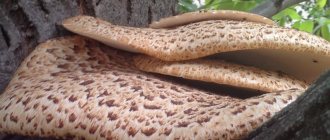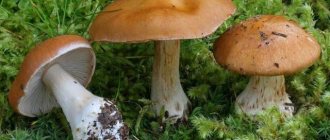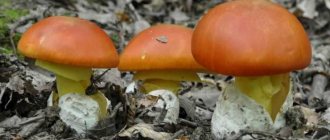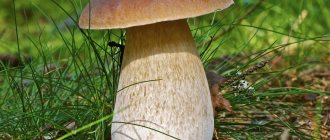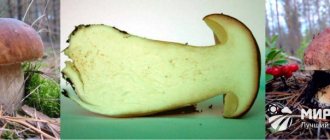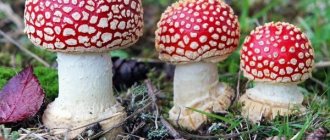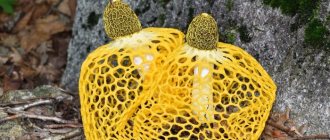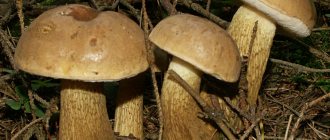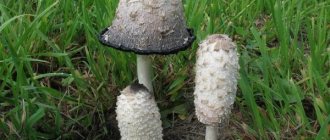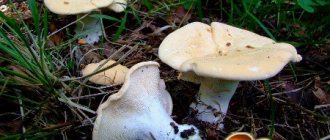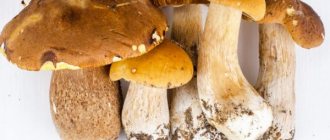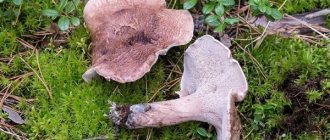Fungotherapy - treatment with mushrooms
It is known from history that one of the last Chinese emperors, Puyi, had one wife and 40 concubines.
His cook prepared daily for the ruler various meat dishes with abalone, which the Chinese called “shiitake” (in Japan - “shiitake”). This dish preserved the manhood of the head of a large family. The medicine of Japan and China has known the healing properties of shiitake for more than 2 millennia. Wu Gorin, a famous healer, wrote about them back in 1309 in his work. The healer concluded that they uplift the spirit of the life energy "qi", curing colds, relieving hunger and entering the blood. Consequently, mushrooms increase “vital energy”, “infusing” the “fullness of life” into a person.
By Gorin developed mushroom tea and vodka tincture from rice for the treatment of lupus erythematosus, multiple sclerosis, and other diseases.
The benefits of mushrooms have been known for a long time. In Rus', healers effectively used porcini mushrooms, chanterelles, stitches, and fly agarics to treat many diseases.
Thus, a new direction of treatment was born in folk medicine - fungotherapy.
What does it actually represent - an effective medical trend or pseudoscience?
mushroom treatment
Mushrooms used in folk medicine
There are varieties of mushrooms of this type that are effectively used in folk medicine to treat various diseases; they are added to medicinal tinctures, decoctions, and added to ointments:
- larch sponge (Fomitopsis officinalis) or agaricus. The mushrooms are white or pale yellow in color, oblong in shape, similar to an animal’s hoof. They can reach 10 kg in weight. They grow on coniferous trees or larch stumps. When used as part of a medicine, it weakens, stops bleeding, calms, and acts as a mild sleeping pill. Used to reduce sweat secretion;
Taxonomy
Synonyms
- Agaricus cyprinus Batsch, 1783
- Agaricus flammeus JFGmel., 1792, nom. superfl.
- Agaricus lepideus Fr., 1815 : Fr., 1821basionym
- Agaricus polymorphus Pers., 1828, nom. superfl.
- Agaricus polymorphus var. ceratoides (Holmsk.) Pers., 1828
- Agaricus polymorphus var. proboscideus Pers., 1828
- Agaricus polymorphus var. tubaeformis (Schaeff.) Pers., 1828
- Agaricus squamosus Schaeff., 1774, nom. illeg.
- Agaricus suffrutescens Brot., 1805
- Agaricus tubaeformis Schaeff., 1774
- Amanita crispa Lam., 1783, nom. superfl.
- Clitocybe lepidea (Fr.) P.Kumm., 1871
- Lentinus contiguus Fr., 1874
- Lentinus cryptarum Fuckel, 1870
- Lentinus domesticus P.Karst., 1887
- Lentinus gallicus Quél., 1885
- Lentinus lepideus (Fr.) Fr., 1825
- Lentinus lepideus f. rufescens ANPetrov, 1987
- Lentinus lepideus var. contiguus (Fr.) Rea, 1922
- Lentinus lepideus var. hibernicus McArdle, 1909
- Lentinus magnus Peck, 1896
- Lentinus maximus AEJohnson, 1878
- Lentinus monnardianus Durieu & Mont., 1845
- Lentinus platensis Speg., 1898
- Lentinus queletii Schulzer, 1885
- Lentinus sitaneus Fr., 1836
- Lentinus spretus Peck, 1906
- Lentinus squamosus (Schaeff.) Quél., 1888
- Lentodium squamosum (Schaeff.) Murrill, 1911
- Neolentinus suffrutescens (Brot.) TWMay & AEWood, 1995
- Panus lepideus (Fr.) Corner, 1981
- Pocillaria lepidea (Fr.) Kuntze, 1891
- Ramaria ceratoides Holmsk., 1799
Scaly sawfoil (Neolentinus lepideus)
Cap: at first the cap of the mushroom has a convex shape, during the process of ripening it flattens and takes on a funnel-shaped shape. The surface of the cap is dry, yellow, light brown or grayish-white in color with medium-sized brown or brown scales. The cap reaches 3-12 cm in diameter.
Leg: 6 cm high, 1-2.5 cm wide. The central one is eccentrically located, cylindrical in shape. Toward the bottom, the leg narrows slightly, can be root-like, elongated, whitish in color with reddish or reddish-brown scales.
Pulp: elastic, tough with a pleasant mushroom smell; in an adult mushroom the pulp becomes woody.
Plates: descend along the stem, grayish-white or yellowish in color. The edges are jagged. The presence of noticeable denticles is considered the main distinguishing feature of sawfoil.
Spore powder: white.
Edibility: the mushroom can be eaten, but only at a young age, while the flesh is still quite soft; ripe mushrooms are not suitable for consumption. There is no information about the toxicity of the mushroom.
Similarity: can be confused with other similar large scales and sawfoils, which are characterized by low nutritional quality and are inedible.
Distribution: Found on conifer stumps and dead wood, as well as on telegraph poles and railroad sleepers. Grows singly or in small groups. Fruits from early June to September. The fruiting bodies germinate very slowly, decorating the pillars and trunks with their presence for a long time.
Video about the Sawfoil scaly mushroom:
Notes: Sawfoil is one of the most serious destroyers, as it is able to exist on specially treated wood of posts and sleepers, destroying it.
Photo of the mushroom Sawfoil scaly (Sleeper mushroom)
from questions in recognition:
LAT
Characteristics:
| Group: | Lamellar |
| Records: | From whitish and yellowish to dirty brown |
| Color: | Yellow, brownish or off-white |
| Info: | Brown scales on the cap |
Taxonomy:
| Department: | Basidiomycota (Basidiomycetes) |
| Sub-department: | Agaricomycotina (Agaricomycetes) |
| Class: | Agaricomycetes (Agaricomycetes) |
| Subclass: | Incertae sedis (uncertain position) |
| Order: | Polyporales |
| Family: | Polyporaceae |
| Genus: | Neolentinus (Neolentinus) |
| View: | Neolentinus lepideus (Sawleaf) |
How to properly cook mushroom?
It is suitable for pickling and salting, it can also be boiled and dried. Cooking is not difficult, the main thing is to collect only young specimens, and use the caps for cooking. In older mushrooms, the pulp becomes too hard and inedible.
Primary processing before cooking
Since the mushroom does not grow on the ground, but on wood, its surface is usually clean. The stems should be cut off and discarded and washed.
Cooking
The sleeper is boiled in salted water for 30 minutes. After this treatment, you can add it to stews or other dishes, or cook soup with it. Saw leaf goes well with meat.
Pickling
Prepare a marinade for boiled mushrooms. For 1 liter of water you will need:
- 1 tbsp. l. salt;
- 1 tbsp. l. Sahara;
- 1 laurel leaf;
- 3 buds of cloves;
- 2 tsp. vinegar;
- horseradish and currant leaves optional;
- 3 cloves garlic, minced.
All this is placed in a saucepan with water and put on fire, after boiling, add mushrooms and cook for another 15 minutes. Then the sleepers are laid out in jars, filled with marinade, and covered with lids. They should be stored in the refrigerator on the bottom shelf.
Pickling
Pre-boiled mushrooms are also used for it. After draining excess water, the sawfoils are placed in prepared containers in layers, which are sprinkled with salt and your favorite spices. This can be garlic, allspice, bay leaf, cloves and others.
Then everything is covered with several layers of gauze and pressed down with a weight. Mushrooms are salted for 40 days, and periodically it is necessary to wash the fabric or lay a new one to avoid the appearance of blooms. A week from the start of the process, the mushrooms should be completely covered with juice; if this does not happen, you need to increase the load or add salt water (per 1 liter - 2 tablespoons of salt).
Finally, the mushrooms should be placed in jars, the remaining space should be filled with brine and the product should be placed in a cool, dark place.
Drying
For it, the mushrooms also need to be boiled first, and then, placed on a baking sheet, dried in the oven or convection oven. To make the process go faster, the caps should be cut into smaller pieces and turned over periodically. Drying will take at least 5 hours.
The sleeper mushroom is not common, so it is rarely collected and eaten, but it is not considered poisonous. And in some countries it even refers to medicinal. It has no special taste value, and is often classified as the third or fourth group
Whether or not to collect scaly sawfoil is up to everyone to decide for themselves, but if there are tastier and healthier mushrooms in the forest, then it’s better to pay attention to them
Description of the species
Young specimens of the species have a rather convex cap, which gradually melts as the mushroom grows, forming a funnel-shaped depression in the inner part. The edges of the cap are quite thin. The diameter of this part of the mushroom does not exceed 100 mm. The color ranges from dirty white to light brown with some yellowness. On a dry surface, small scales of brown or brownish color can be clearly seen. Larger scales are located closer to the central part.
The lamellar body of the scaly sawfoil is distinguished by plates with rather large notches, their color varies from dirty yellow to brown. The flesh of this species is white in young specimens, dense and elastic, and hardens as it matures. The pulp of the fruiting body has a pleasant mushroom aroma.
The leg is regular in shape, solid, tapering towards the base. The color of this part of the sleeper mushroom is dirty white, the surface is covered with small reddish scales.
morel cap - description of where it grows, the toxicity of the mushroom
False doubles
Due to the fact that the mushroom grows in strictly defined places, it is quite difficult to confuse it with others. However, there are still varieties that are similar in appearance. You can see them better in the photo.
| Name | Color | Cut location | Growing area | Danger |
| sleeper mushroom | Light, whitish or yellowish with brown scales | Slightly yellow, reddish | On rotting pines, sleepers and poles | Edible |
| Sawfoil goblet | Red and white | Color does not change | Southern regions, rotting deciduous trees | Inedible |
| Tiger Sawfoil | White with brown scales | Blushes | Coniferous forests, deadwood | Conditionally edible |
Sawfoils are mainly collected by their connoisseurs; many point to the excellent taste of the mushroom. It is worth noting that the well-known shiitake also belongs to this genus.
Sleeper mushroom - description of where it grows, toxicity of the mushroom
Sleeper mushroom is an edible species of mushroom belonging to the polyporaceae family. Despite its edibility, this species is little known, so many mushroom pickers, when they see it, simply avoid it. Another name for representatives of this species is scaly sawfoil.
Description of the species
Young specimens of the species have a rather convex cap, which gradually melts as the mushroom grows, forming a funnel-shaped depression in the inner part. The edges of the cap are quite thin. The diameter of this part of the mushroom does not exceed 100 mm. The color ranges from dirty white to light brown with some yellowness. On a dry surface, small scales of brown or brownish color can be clearly seen. Larger scales are located closer to the central part.
The lamellar body of the scaly sawfoil is distinguished by plates with rather large notches, their color varies from dirty yellow to brown. The flesh of this species is white in young specimens, dense and elastic, and hardens as it matures. The pulp of the fruiting body has a pleasant mushroom aroma.
The leg is regular in shape, solid, tapering towards the base. The color of this part of the sleeper mushroom is dirty white, the surface is covered with small reddish scales.
Places of growth
Most often, this type of mushroom can be found growing on fallen and dead trees; in fact, representatives of this species feed on decaying wood. In addition to dead wood, stumps and fallen trees, groups of fungi can also grow on various wood products, sleepers and telegraph poles, thereby destroying their structure. Note that in order to preserve the service life of such products, the latter are coated with a special antiseptic. However, this does not harm the sawfoil at all, which, on the contrary, likes such “impregnation”, in fact, which is why this species got its name - sleeper mushroom.
Where is the best place to collect?
Although the type of mushroom presented to our attention is edible, nevertheless, there are unlikely to be many people who want to try culinary delights with mushrooms growing on creosote-impregnated wood
Please note that mushrooms growing on sleepers can be harmful to health because they accumulate quite a large amount of harmful substances that negatively affect the human body.
Therefore, if you decide to harvest sawfoil, in this case these mushrooms should be collected in the forest thicket. For collection, it is better to choose young specimens, the preparation of which involves pickling and salting.
Poisonous doubles
The sleeper mushroom has a characteristic appearance, so it is quite difficult to confuse it with other species; at present, there is no information about the dangerous and poisonous doubles of this mushroom for humans.
Beneficial features
Due to their nutritional value, mushrooms such as sawfoils are widely used in oriental dishes. In addition to its nutritional value, sleeper mushroom is also very useful; when dried, it has a good antitumor effect in the treatment of cancer. Also, the use of sawfolium promotes the formation of useful substances, including interferon, which effectively fights many infectious diseases.
Saw leaf goblet - this mushroom is not used for preparing culinary dishes, as it is an inedible species. The hat has a characteristic funnel shape, the color is reddish-white. The caps of adult mushrooms are usually white, due to their fading. The surface of the skin of the fruiting body is dry, covered with fine hair, the edges are uneven. The pulp is quite elastic, with a pleasant aroma of fresh fruit. The mushroom stalk is small in size, but at the same time quite thick, almost completely covered with plates. Most often this species grows on damaged deciduous wood. Tiger sawfoil is a mushroom that is classified as a conditionally edible species. The mushroom cap has an asymmetrical shape, funnel-shaped. The surface is dry, densely dotted with small brown scales. The leg is white, darkening closer to the base. The pulp is white; when the fruiting body is broken, it almost immediately changes color and becomes red. The fruiting season is from early summer to mid-autumn. Most often, this type of mushroom is found in coniferous forests among accumulations of dead wood.
Use
Sleeper mushroom is classified as edible. Only the caps of young specimens are eaten . Mature sawfoils are not suitable for consumption due to excessive rigidity and the accumulation of large amounts of harmful substances.
Important! To prepare dishes, you need to collect only those mushrooms that grow on fallen trees. Those growing on sleepers and other wood are not suitable for food, since these materials are treated with the substance creosote.
Scientific studies
Scientists did not stop at discovering the antitumor properties of shiitake mushrooms. They found “volatile compounds” in them - incredible “virus-like particles”. They freely penetrate various viruses and destroy them. The particles were called “fungal phytoncides.” It turned out that they help the body produce interferon, a strong component of the immune system. It prevents the virus from multiplying. The amount of interferon produced is sufficient to protect against the flu.
Moreover, “mushroom phytoncides” can resist almost all viruses (hepatitis, herpes, even HIV). Research conducted at the Tokyo Institute of Immunology confirms that shiitake medicine is active in the fight against AIDS - much more effective than those obtained previously.
The named mushrooms were included in the study back in the USSR Ministry of Health. The findings obtained at the cardiology center turned out to be quite significant: 5 hours after a single dose of mushroom infusion, toxic blood serum “lost its ability to accumulate cholesterol.” In addition, a persistent decrease in pressure was observed after two weeks of treatment. Reishi mushroom also has this effect on the body.
Unfortunately, the research experiments were canceled then, despite the growing authority of fungotherapy
And only recently has medicine again paid attention to the “mushroom potential”. In g
The St. Petersburg Pharmaceutical Academy developed a method for using shiitake and produced a Russian dietary supplement of the same name. However, it did not receive development, remaining difficult to access even in St. Petersburg.
In Moscow and other large cities, fresh shiitakes are sold. True, they are not suitable for treatment, because medicines are prepared from the “koshin shiitake” species. And this is the Donko Shiitake variety.
Today there are already many methods for using medicinal mushrooms (growing in Russia) against various diseases. Autoimmune diseases are cured - every second case shows improvement, the disease almost always stops.
In oncology, antitumor mushrooms also work wonders: persistent improvement is observed, the disease does not progress, and metastasis stops. Well, with stopped oncology you can live a long time, however, constantly taking mushrooms. There are many cases of complete healing, even in the later stages. Fungotherapy is progressing.
Tree ears (saw leaf)
tree abalone medicinal mushrooms For a long time, Europeans believed that shiitake lives only in the countries of warm Asia. And only when mycologists were shown tree ears, they realized that this organism belongs to mushrooms, but not like cap mushrooms. It turned out that they belong to the order Agaricaceae (lamellae). Moreover, Europeans were already familiar with this mushroom under the name lentinus or sawfoil.
It usually grows in deciduous forests (on stumps, on dead wood), sometimes found in large groups. An excellent substrate for this fungus is wood waste, chicken droppings, and farm waste. The mushroom adapts very well to life in unpretentious environmental conditions.
In its dry form, it cannot be called particularly elegant. Despite complete indifference to the place where it grows, the mushroom has excellent taste. It can be eaten raw (the taste is reminiscent of radish).
Currently, biologists and doctors are studying sawfoil in several directions: the technology of growing the crop is being developed, the biochemical composition is being studied, and the healing properties are being tested.
It is also found in our country (one of the representatives is the sleeper mushroom), however, Russians are not very accustomed to these mushrooms and do not use them in food and fungotherapy, so chanterelles, which are familiar to Russians, can serve as a somewhat weak replacement for ears.
Using stumps to grow mushrooms
The stumps can be used to grow oyster mushrooms. This is easy to do, for example, at a summer cottage. To do this, you will need a shady area or room and several stumps from deciduous trees (birch, aspen, apple, pear, acacia, poplar). Coniferous crops are not suitable for these purposes.
The stumps should not be old, ideally if they are freshly cut. Dry ones will need to be soaked in water for several days. Their sizes do not make a fundamental difference. Convenient sections with a diameter of 15 to 40 cm and a height of 40 to 50 cm.
Oyster mushrooms can be grown both in open areas and indoors. If you plan to place stumps outside, the place should be in the shade and well ventilated. At temperatures below +20°C, agrofibre cover will be required. The optimal time for planting is April-May and August-September. The mycelium germinates within three months.
There are several ways to stack logs. In each of them you will need to dig a ditch at least 30 cm deep and wide, corresponding to the diameter of the wooden blanks. If you have supports for the logs, you don’t have to dig the ground, but place the stumps on its surface.
There are also several ways to introduce mycelium into a stump - for example, by drilling holes, by sawing off the top part, by building a pyramid of logs with several layers of mycelium, etc.
In winter, the stumps will need to be brought indoors or covered with straw or agrofibre.
Important! An important condition for growing oyster mushrooms in an open area is to regularly moisten the soil around the stumps. A drip irrigation system is best suited for these purposes.
disinfect
It is most convenient to lay the logs horizontally, on top of each other, after seeding them with mycelium in the basement or barn. On top they are covered with burlap or perforated film.
When installing logs vertically, they are made into columns and covered with straw and sawdust. The sides of the columns are covered with film or burlap.
The air in the room should be constantly humid. Frequent ventilation is mandatory.
In May, the stumps can be transplanted into the ground in the open air.
Taxonomy[ | ]
Synonyms
- Agaricus cyprinus Batsch, 1783
- Agaricus flammeus JFGmel., 1792, nom. superfl.
- Agaricus lepideus Fr., 1815 : Fr., 1821basionym
- Agaricus polymorphus Pers., 1828, nom. superfl.
- Agaricus polymorphus var. ceratoides (Holmsk.) Pers., 1828
- Agaricus polymorphus var. proboscideus Pers., 1828
- Agaricus polymorphus var. tubaeformis (Schaeff.) Pers., 1828
- Agaricus squamosus Schaeff., 1774, nom. illeg.
- Agaricus suffrutescens Brot., 1805
- Agaricus tubaeformis Schaeff., 1774
- Amanita crispa Lam., 1783, nom. superfl.
- Clitocybe lepidea (Fr.) P.Kumm., 1871
- Lentinus contiguus Fr., 1874
- Lentinus cryptarum Fuckel, 1870
- Lentinus domesticus P.Karst., 1887
- Lentinus gallicus Quél., 1885
- Lentinus lepideus (Fr.) Fr., 1825
- Lentinus lepideus f. rufescens, 1987
- Lentinus lepideus var. contiguus (Fr.) Rea, 1922
- Lentinus lepideus var. hibernicus, 1909
- Lentinus magnus Peck, 1896
- Lentinus maximus, 1878
- Lentinus monnardianus Durieu & Mont., 1845
- Lentinus platensis Speg., 1898
- Lentinus queletii Schulzer, 1885
- Lentinus sitaneus Fr., 1836
- Lentinus spretus Peck, 1906
- Lentinus squamosus (Schaeff.) Quél., 1888
- Lentodium squamosum (Schaeff.) Murrill, 1911
- Neolentinus suffrutescens (Brot.) &, 1995
- Panus lepideus (Fr.) Corner, 1981
- Pocillaria lepidea (Fr.) Kuntze, 1891
- Ramaria ceratoides Holmsk., 1799
What does sawleaf look like?
During a quiet hunt, many mushroom pickers pass by this species, not knowing that it can be eaten and that it has beneficial properties. To recognize scaly sawfoil, you need to know its external characteristics.
Description of the cap
The cap of the scaly sawfoil is rounded and convex, and gradually straightens with age, leaving a small depression in the center. The surface is covered with dirty white or gray-brown skin, which cracks in dry weather. The cap with a diameter of 10 cm or more has numerous brownish-brown scales. The bottom layer is formed by thin plates of a dirty yellow color. Reproduction occurs by microscopic spores, which are located in a whitish powder.
Description of the leg
The cylindrical leg reaches a length of up to 6 cm. Closer to the ground it narrows and becomes root-like and elongated. The surface is covered with whitish skin with red or light brown scales. In young specimens, the flesh is soft, elastic, with a pleasant mushroom taste and smell. With age, it becomes tough, so old mushrooms are not used for food.
Characteristics of sawfolium mushroom
hat
— Advertising —
The sawfoil cap is 4-10 cm in diameter, the edge is thin. In young mushrooms, the shape of the cap is convex; with age, a funnel-shaped shape appears in its center. The surface of the cap is whitish, covered with bristly scales of black-brown color. The scales are arranged in circles, most of them in the center. The color of the cap changes from white to brown as the mushroom matures.
The pulp is whitish in color with a characteristic pungent odor. In some species it is very elastic.
Leg
— Advertising —
The leg is thin, 3-5 cm in diameter, irregular in shape, often curved. On the surface of the leg there are the same scales as on the cap. The leg tapers downward.
Sawwort, Lentinus lepideus
Hat:
3-12 cm in diameter, fleshy, hemispherical or convex in young mushrooms, gradually opens and thinns with age, acquiring a complex “convex-depressed” shape, often with uneven edges. The color of the cap is from dirty white to equally dirty brown, the surface is dry, covered with velvety large scales, only slightly darker than the cap. The flesh of the cap is light, thick, very elastic, in older specimens it is dry, with a pleasant mushroom smell.
Hymenophore:
The plates are deeply descending, relatively sparse, of medium width, cap-colored or slightly lighter. A characteristic feature is the presence of noticeable “teeth” on the plates, which gave the name to the entire genus Sawfoil.
Spore powder:
White.
Leg:
Central or eccentric, often curved and thinned at the base, length and thickness vary greatly depending on growing conditions (thickness - 1-3 cm, length - 2-10 cm). The flesh of the leg is fibrous, very elastic and dry.
Spreading:
It is found from mid-July to mid-September on the remains of coniferous trees, not least on processed wood (sleepers, poles, etc. - it is no coincidence that the scaly sawfoil was called the “sleeping mushroom”), as a rule, rarely and not abundantly - one at a time specimen, less often in small groups. Fruiting bodies develop slowly, decorating trunks and pillars with their presence for a long time. By destroying the processed wood of sleepers and posts, the fungus is said to be of great economic importance.
Similar species:
Given the nature of its growth, it is very difficult to confuse Lentinus lepideus with any species other than closely related ones. (Although the author, for example, managed to confuse it with destructive scale, but this was simply due to an excess of imagination and practical laziness.) Tiger sawfolium (Lentinus tigrinus) is smaller, has a funnel-shaped cap and usually grows in clumps.
Edibility:
At a young age, they write, the mushroom is quite edible. A pleasant smell, of course, in some sense encourages experimentation, but first you need to find these “young specimens”.
Author's notes:
I have a rather strange embarrassment associated with the scaly sawfoil. Seeing a large, shaggy, whitish mushroom on a neighbor’s pole, which had only recently been erected, I for some reason decided that I was seeing destructive flakes, which are found all too often in the Venevsky district; saw, and instead of critically comprehending what he saw, he composed a story about how careless electricians installed a poplar pole instead of the ordered pine (or spruce) pole, cutting down a random tree in the trash heap, and the mushroom gave them away. The story may be spectacular, but it is completely unreliable, and worse, it is easily verifiable: a refutation is hatched by itself after the first clear glance at the photograph of the “scaly”. Of course, this is a real sleeper mushroom, which means that the electricians suffered the feuilleton criticism completely in vain. The pillar our neighbors were given was actually a coniferous one - the mushroom won’t lie. That's how a person would be.
The wire on the right adds a man-made feel to the picture. The sleeper-pillar mushroom, scaly sawfolium, sprouted on an almost new electric pole, and remained relatively unchanged for a good month, and then suddenly disappeared somewhere overnight. It must be assumed that the neighbors' nerves could not stand it - apparently, they had not encountered many “eternal” mushrooms until now. And Lentinus lepideus is just one of these, and the epithet “edible when young” may actually mean that it should be collected exclusively in the first three days out of a possible thirty.
Having grown on a decent substrate, not on a post or fence, Neolentinus lepideus looks quite respectable, more reminiscent of some kind of very large scale.
When placed in a research perspective, scaly sawfoil demonstrates all the qualities of a strong mushroom, ready to overcome any difficulties on the way to a great goal. There is scaliness and serration of the plates; The sleeper hardness of the pulp is not visible, but is undoubtedly discernible.
In old age (and it can last as long as desired), the scaly sawfoil becomes coarser, hardens, showing with all its appearance that it is not going to surrender to inexorable time without a fight. At such a moment it is easy not to recognize it, or even to confuse it from a distance with some kind of scale.
Places of growth
The peak of fruiting of the sleeper mushroom occurs at the beginning of the warm season and continues until mid-autumn. The best time to harvest scaly sawfoil is mid-summer. Most often, this type of mushroom can be found growing on fallen and dead trees; in fact, representatives of this species feed on decaying wood. In addition to dead wood, stumps and fallen trees, groups of fungi can also grow on various wood products, sleepers and telegraph poles, thereby destroying their structure. Note that in order to preserve the service life of such products, the latter are coated with a special antiseptic. However, this does not harm the sawfoil at all, which, on the contrary, likes such “impregnation”, in fact, which is why this species got its name - sleeper mushroom.
Distribution and growth time
Scaly sawfoil settles on dead coniferous trees, most often on pine trees. The mushroom also grows on dead wood and stumps.
It can often be seen growing in such unusual places:
- on sleepers;
- in coal mines;
- in cellars;
- in wells;
- on various woods;
- on pillars.
The habitat of the species is areas with a temperate climate in Europe. The mass fruiting period occurs in July–August. Individual specimens can be found from April to October.
Traditional medicinal use
Universal recipe
- Grind the dried shiitake into powder.
- Pour warm boiled water (150 g) into 10 g of powder, let it brew for 15 minutes, stir.
- Drink daily (along with sediment) 3 times (half an hour before meals). Drinking water is allowed.
The treatment course is 4 months.
The healing effect of this recipe is great: immunity is increased, cholesterol is reduced, the development of cancer tumors is stopped, liver diseases are cured, the body is cleansed of chemical poisoning and the presence of harmful bacteria.
Hypertension, neurological diseases
Take a 5-gram bag of shiitake and leave it in 150 g of cognac for 2 weeks. Take the medicine morning and evening at a dose of 5 g. Within 2 weeks you will feel a noticeable improvement. However, it is advisable to continue treatment for up to 3 months. If necessary, you can repeat it several times after a month's rest. “Imperial mushroom” stabilizes blood pressure and calms nerves.
What is important to know about mushroom treatment
You should know that fungotherapy, in comparison with herbal medicine, works much tougher and more effectively. Currently, the use of medicinal mushrooms is increasing, so it is necessary to strictly follow the recommendations when using them.
- Don't confuse the type of mushroom. Thus, 8 species of polypores grow in Russia, and only one of them has been well studied and passed clinical trials - larch.
- We must not forget about the accumulation of radionuclides and heavy metals by fungi. It is strictly forbidden to purchase medicinal mushrooms from hands, from ignorant people, or in markets. Mushroom preparations sent via the Internet must be tested in a laboratory, as they often simply fail.
- Mushroom tinctures and infusions must be done correctly: mushrooms are “afraid” of high temperatures and high alcohol content. There are also specifics when infusing vodka.
- Well, about deception. Sometimes they send anything under the guise of medicinal mushrooms. There are especially many counterfeits of shiitake mushrooms these days – completely different mushrooms in bags are passed off as them.
And then read: about the benefits and uses of kombucha.
If you find an error, please select a piece of text and press Ctrl+Enter.
Sawfoil mushroom medicinal properties
Shiitake pulp is rich in nutrients. For example, every 100 g of dry mushroom contains 18.6 g of protein, which is higher than that of the “protein” record holders of the porcini mushroom or the fucus fucus. Among the 18 amino acids that make up shiitake proteins, 8 amino acids are essential for the human body. The mushroom is characterized by a high content of fats, unsaturated fatty acids, polynucleotides, polysaccharides, minerals (calcium, phosphorus, iron, manganese, zinc, copper, magnesium and selenium) and vitamins. Shiitake also contains ergosterol (provitamin D, which can be converted under the influence of UV rays into vitamin D2) and fungesterol. From a medicinal point of view, edible sawfoil has antitumor and immunostimulating effects, reduces lipid and cholesterol levels and prevents thrombus formation, has hepatoprotective, antibacterial and antiviral activity, tonic and restorative properties.
The polysaccharide lentinan (LNT) found in shiitake mushrooms exhibits high antitumor activity. It stimulates the activity of the immune system, increases phagocytic activity, increases the production of the polymer protein perforin in CTLs, damages atypical cells, leading to their death, and at the same time stimulates an increase in the number of T-fractions of lymphocytes (T-killer and T-helper cells), killer cells and tumor necrosis factor (TNF). Shiitake is especially useful for restoring the body after surgery, and currently lentinan is considered one of the best auxiliary active agents. The polysaccharide also has other important pharmacological effects related to immunodeficiency states. Other polysaccharides extracted from shiitake also exhibited antitumor and immunostimulating effects. For example, a complex polysaccharide containing a mannan-peptide compound (KS-2) and emitin, which actively inhibit the growth of tumors, has been isolated. Studies have shown that this polysaccharide is non-toxic, helps improve immune responses, and within five weeks stimulates the reverse development and disappearance of tumors in sarcoma-180 and ascites hepatoma-134.
Popular articles Features of propagation of phalaenopsis at home
Goblet leaf (Neolentinus cyathiformis)
Lentinus cyathiformis
Cap: Funnel-shaped, up to 25 cm in diameter, reddish-beige, with uneven, rather weakly defined concentric zones; in old age it fades to whitish with a dark spot in the middle. The shape is at first hemispherical, with age it opens up to funnel-shaped; the edge is usually uneven. The surface is dry, slightly fleecy.
The pulp of the goblet sawfolium is white, very elastic (you can tear the mushroom with only two hands), with an extremely pleasant smell, reminiscent of the smell of fruit.
Lamellae: Frequent, narrow, saw-toothed, strongly descending along the stalk (almost to the base), white in youth, then creamy, darkening to dirty brown.
Spore Powder: White.
Leg: Short and thick (height 3-8 cm, thickness 1-3 cm), often tapering towards the base, very rigid, almost entirely covered with plates, blackish at the base.
Distribution: Goblet sawgrass is found on the rotting remains of deciduous trees (apparently, it can also parasitize living ones, causing white rot). The goblet leaf is a predominantly southern mushroom; it is not found so often in our area. The fruiting body lasts a long time, and its attractiveness to some, so to speak, rodents, leads to the fact that the mushroom is gnawed faster than it dies from old age.
Similar species: Apparently not. We are more likely talking about synonyms. Lentinus degener, Lentinus schaefferi, Panus cyathiformis - this is not a complete list of pseudonyms for goblet sawfoil.
Edibility: Information on the Internet is quite contradictory. We can only say with certainty that no toxic substances have yet been found in this mushroom. The most common information is that goblet sawleaf is inedible due to its too dense, “rubbery” pulp. But it’s worth trying this mushroom at a young age to dispel all doubts!
Notes I discovered several colonies of these amazing mushrooms on June 14, 2003, in a birch forest, old and quiet. It seems that this is the first “plate” mushroom that I could not break with one hand. And I couldn’t do it with both hands—I had to twist and tear. Of course, this could not fail to inspire respect. I was determined to find out what this find of mine was called.
The answer was found only after a year and a half. Knowledgeable people advised me to look among the sawfoils, pointing to Lentinus cyathiformis as a guide. You didn’t have to go far: he is there.
The mushroom is, of course, quite southern. If we take amateur mushroom sites, then in the Czech Republic and Slovakia it is still considered quite rare (but is already considered, unlike our resources), and in Bulgaria it is completely in the order of things. At the same time, finds of goblet sawfoil were also noted in Denmark.
That, in fact, is almost all that I managed to find out. It is also known that Lentinus cyathiformis causes white rot of wood, and for some reason some institutes sell a strain of this fungus over the Internet (and buyers representing non-profit organizations are offered a large discount). And, of course, the traditional war of synonyms. Where would mycology be without it?
Now I’m thinking: has anything changed because I learned what specially trained people call the mushroom I found? Although, of course, this is a very banal thought, and it’s a shame to think about it.
An excerpt characterizing Tiger Sawfoil
After dinner, Speransky’s daughter and her governess got up. Speransky caressed his daughter with his white hand and kissed her. And this gesture seemed unnatural to Prince Andrei. The men, in English, remained at the table and drinking port. In the middle of the conversation that began about Napoleon's Spanish affairs, which everyone was of the same opinion approving, Prince Andrei began to contradict them. Speransky smiled and, obviously wanting to divert the conversation from the accepted direction, told an anecdote that had nothing to do with the conversation. For a few moments everyone fell silent. After sitting at the table, Speransky corked a bottle of wine and said: “nowadays good wine goes in boots,” gave it to the servant and stood up. Everyone got up and, also talking noisily, went into the living room. Speransky was given two envelopes brought by a courier. He took them and went into the office. As soon as he left, the general fun fell silent and the guests began to talk to each other judiciously and quietly. - Well, now the recitation! - said Speransky, leaving the office. - Amazing talent! - he turned to Prince Andrei. Magnitsky immediately struck a pose and began to speak French humorous poems that he had composed for some famous people in St. Petersburg, and was interrupted several times by applause. Prince Andrei, at the end of the poems, approached Speransky, saying goodbye to him. -Where are you going so early? - said Speransky. - I promised for the evening...
Mushroom therapy, reality or advertising?
About 20 years ago, Japanese biology professor Goro Chihara announced that he knew a drug that could stop cancer. These are shiitake mushrooms growing on trees. The biologist argued: these mushrooms work on a new principle. They do not destroy tumor cells, but force the body to produce perforin (an enzyme that it produces specifically to fight cancer cells that form every day). Thus, it is possible to destroy tumors without introducing any poisons into the body.
Goro-san confirmed this clinically: the use of the Shiitake drug caused complete regression of the sarcoma.
Mushrooms from Japan have gained enormous “authority” on the American continent. The famous singer Michael Jackson drank shiitake tea every morning, praising its extraordinary healing properties and referring to it as a means of immortality.
American singer Madonna Louise Ciccone advertises these mushrooms for the freshness and elasticity of her skin. What is described above is more likely half true and half show.
However, in the West they began to intensively develop fungotherapy, investing heavily in the study of tree mushrooms from Japan (shiitake, meitake, reishi).
Reasons for the growth of mushrooms on tree stumps
Individuals settling in this way are classified as saprophytic fungi that feed on the remains of various microorganisms. They parasitize on the body of a stump or living tree, destroying the wood. Fungal spores spread in areas of damage, forming mycelium, which allows the fungi to go deeper into the wood, affecting it.
Causes of mushrooms on stumps:
- Mechanical damage (cutting, breaking).
- Irregular garden care.
- Pest damage to trees.
- Special colonization of fungal spores on stumps or trees for the purpose of growing edible species.
Wood-destroying edible mushrooms grown in households or on large farms (honey mushrooms, oyster mushrooms, shiitake mushrooms) have become a source of good profit in modern business.
Poisonous wood-destroying organisms cause irreparable damage to fruit trees, leading to their death and contamination of the entire garden. Therefore, trees affected by such parasites should be uprooted and destroyed in a timely manner to prevent the spread of fungal spores to other plants.
Interesting facts about the mushroom
If you find an error, please highlight a piece of text and click
Ctrl+Enter.
The goblet sawfolium mushroom belongs to the genus Sawfolia. They have characteristic “teeth” on their plates, which is why this genus got its name.
They are affilophorous fungi. They have a destructive effect on wood. Under their influence the tree rots. Therefore, this mushroom can cause considerable harm to the farm. Another version of the origin of the name is the ability to act destructively on wood.
More than 1000 species of mushrooms belong to this genus. Some sources say that today the genus includes several thousand species.
Almost all species belonging to this genus are conditionally edible. But among them there are also inedible species, of which there are few. In China and Japan, it is believed that edible sawfoil is an absolutely edible mushroom.
Among all sawfoils, there are several species that mushroom pickers are confident in and always collect. These are tiger, shell-shaped, and also scaly sawfoil.
The following species are also known to be inedible and have no nutritional value. These are goblet, wolf-shaped, and also grooved species. The remaining species of this genus are poorly studied by science or grow in countries far from Russia.
The goblet sawfoil part of its name comes from the fact that they tend to destroy wood. The second part of the name is related to the shape of the fruiting body. It takes on the shape of a glass already in adulthood.
Fact!
This fungus is a saprotroph that destroys wood. It usually destroys wood that is susceptible to rotting. They grow on dead wood in the forest, on the stumps of trees of various species, including conifers.
Some sources say that all representatives of the genus are poisonous mushrooms. Others say it is simply inedible. But it would be advisable to divide these species into those that can be eaten and those that cannot. There is no exact scientific data on how poisonous those mushrooms of this genus are that should not be eaten.
The species in question, goblet sawfoil, is considered practically unsuitable for human consumption. It does not contain poisons, but it does not have good taste, and the composition of the mushroom does not have any nutritional value.
Process and conditions for destruction by fungi
- The beginning of the process of wood fungus infection can easily be missed. This happens because the threads called hyphae, which make up mushrooms, are not visible to the human eye.
- Threads of mushrooms permeate the perimeter and layers of wood. They secrete special enzymes that dissolve the walls of wood, which serve as food for the fungus.
- When damaged by fungi, the strength and volumetric weight of the wood decreases. The tree becomes flabby and light. Over time, fungus eats and eats wood, causing it to change its natural color. Affected wood may turn red, yellow, brown or tan.
- At a late stage of fungal infection, deep cracks, pits or dents form in the wood, which causes the wood to fall apart into pieces and fibres.
- Moisture and temperature are the main conditions for the development of fungi on wood. Different mushrooms “require” different humidity levels. On average, “comfortable” humidity for mushrooms is about 30-60 percent.
Therefore, it is important, when choosing a material, to pay special attention to how dry the wood is. Humidity should be no more than 20%. Also interesting:
Also interesting:
- Do-it-yourself veneering
- How to treat a wooden surface before painting
- How to process the ends of a log house
- How to renew old wood
Mushrooms of Russia (41 pages)
Hat. Diameter up to 7 cm, rounded-convex, later flat, smooth, shiny in dry weather, sticky in damp weather. Color orange-brown, rusty-brown, red-brown, yellow-brown. The tubular layer is adherent or descending, reddish or rusty brown, the pores are large, angular. The pulp is soft, yellow, turns red when cut, odorless, with a peppery taste.
Leg. Height up to 7 cm, diameter up to 1.5 cm, cylindrical, often curved, dense, the same color as the cap, yellow below.
Spore powder. Yellow-brown.
Habitat. Most often it grows in pine forests, less often in spruce, mixed and deciduous forests.
Season. Summer autumn.
Similarity. It looks a bit like the goat mushroom (Suillus bovinus), which grows in the same places, but if you just lick the pepper mushroom under the cap, it will immediately reveal itself.
Use. In many sources, the mushroom is called inedible, but it can be used instead of pepper when pickling.
Medicinal properties. Pepper mushroom is used in small quantities as a seasoning, which stimulates digestion. Kozlyak is one of the leaders among cap mushrooms in terms of antibiotic content.
Definitioner
Lat. Basidia. A specialized structure of sexual reproduction in fungi, unique to basidiomycetes. Basidia are terminal (end) elements of hyphae of various shapes and sizes, on which spores develop exogenously (outside).
Basidia vary in structure and method of attachment to hyphae.
Based on the position relative to the axis of the hyphae to which they are attached, three types of basidia are distinguished:
Apical basidia are formed from the terminal cell of the hypha and are located parallel to its axis.
Pleurobasidia are formed from lateral processes and are located perpendicular to the axis of the hypha, which continues to grow and can form new processes with basidia.
Subbasidia are formed from a lateral process turned perpendicular to the hyphal axis, which stops growing after the formation of one basidium.
Based on morphology:
Holobasidia are single-celled basidia, not divided by septa (see Fig. A, D).
Phragmobasidia are divided by transverse or vertical septa, usually into four cells (see Fig. B, C).
By type of development:
The heterobasidium consists of two parts - the hypobasidium and the epibasidium developing from it, with septations (see Fig. C, B) or without them (see Fig. D).
Homobasidia is not divided into hypo- and epibasidia and in all cases is considered to be holobasidium (Fig. A).
The basidium is the site of karyogamy, meiosis, and the formation of basidiospores. Homobasidy, as a rule, is not functionally divided, and meiosis follows karyogamy. However, the basidia can be divided into probasidium, the site of karyogamy, and metabasidium, the site of meiosis. Probasidium is often a resting spore, for example in rust fungi. In such cases, the probasidium germinates into a metabasidium, in which meiosis occurs and on which basidiospores are formed (see Fig. E).
See Karyogamy, Meiosis, Hypha.
Amyloid (Amyloid structure)
The structure is called amyloid if the Meltzer reagent (solution of 0.5 g of crystalline iodine + 1.5 g of potassium iodide + 20 ml of chloral hydrate + 20 ml of distilled water) turns blue, violet, and sometimes almost black.
Cooking methods
Saw leaves are not suitable for boiling or frying. They can only be prepared by salting or marinating. They need preliminary preparation. These mushrooms need to be washed well and soaked for 10–12 hours. Then they should be boiled in salted water for 20–25 minutes.
In Ukrainian and Russian cuisine, sleeper mushrooms are rarely prepared, only if there are no other, more valuable species. But among the Koreans, Japanese and Chinese, this representative of the mushroom kingdom is well known and widespread. When consumed regularly, it is believed to prevent the development of tumors and help strengthen the immune system.
Important! Due to the specific places of growth, the sleeper mushroom is almost impossible to confuse with other species. However, in appearance, the goblet and tiger sawfoil are similar to it
Thus, scaly sawfoil is not a very common edible mushroom. Its taste is mediocre. It is only suitable for salting and pickling and requires mandatory preliminary preparation.
Is the mushroom edible or not?
The mushroom is conditionally edible, but due to its place of growth it does not have many fans. The harvested fruit can be used to prepare fried, boiled or canned dishes.
Important! Since the fruiting body quickly absorbs harmful substances, collection should be carried out away from highways and railway tracks.
Due to its beneficial and medicinal properties, this representative of the forest kingdom has gained popularity among mushroom pickers from the East. In dried form, scaly sawfoil has antitumor properties. When this representative of the forest kingdom is consumed in fried and stewed dishes, the body receives a large amount of useful substances that fight infectious diseases.
